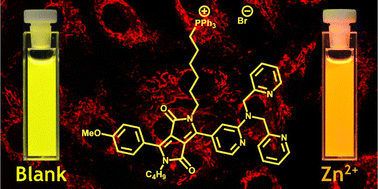A sensitive zinc probe operating via enhancement of excited-state intramolecular charge transfer†
Abstract
Novel highly sensitive fluorescent probes for zinc cations based on the diketopyrrolopyrrole scaffold were designed and synthesized. Large bathochromic shifts (≈80 nm) of fluorescence are observed when the Zn2+-recognition unit (di-(2-picolyl)amine) is bridged with the fluorophore possessing an additional pyridine unit able to participate in the coordination process. This effect originates from the dipolar architecture and the increasing electron-withdrawing properties of the diketopyrrolopyrrole core upon addition of the cation. The new, greenish-yellow emitting probes, which operate via modulation of intramolecular charge transfer, are very sensitive to the presence of Zn2+. Introduction of a morpholine unit in the diketopyrrolopyrrole structure induces a selective six-fold increase of the emission intensity upon zinc coordination. Importantly, the presence of other divalent biologically relevant metal cations has negligible effects and typically even at a 100-fold higher concentration of Mg2+/Zn2+, the effect is comparable. Computational studies rationalize the strong bathochromic shift upon Zn2+-complexation. Decorating the probes with the triphenylphosphonium cation and morpholine unit enables selective localization in the mitochondria and the lysosome of cardiac H9C2 cells, respectively.



 Please wait while we load your content...
Please wait while we load your content...